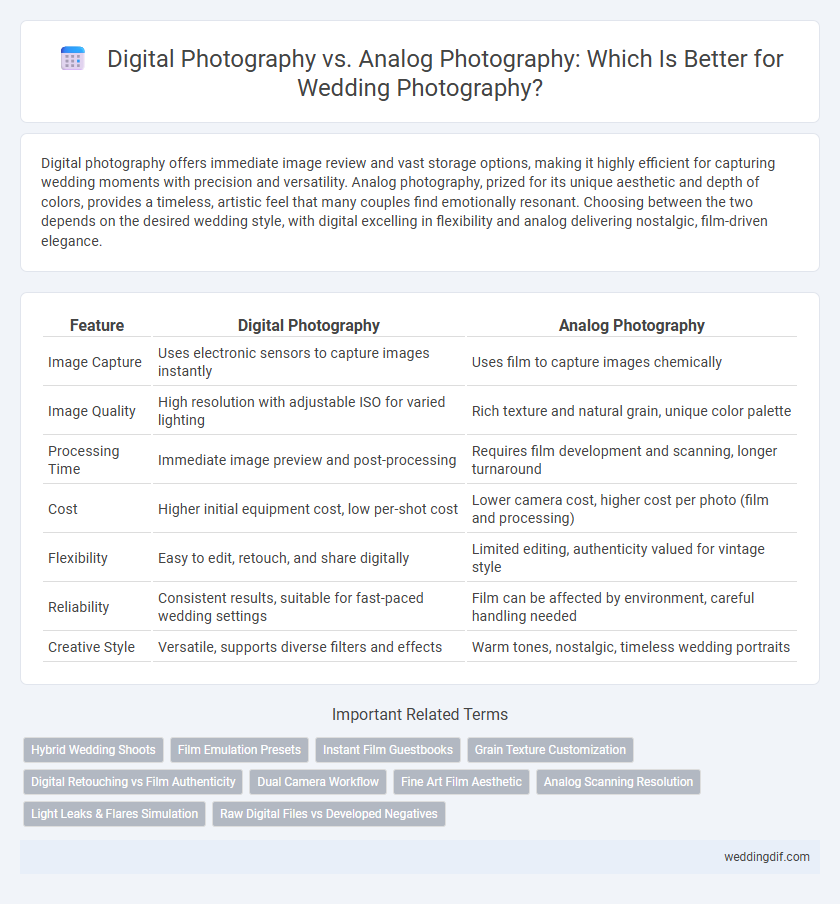Digital photography offers immediate image review and vast storage options, making it highly efficient for capturing wedding moments with precision and versatility. Analog photography, prized for its unique aesthetic and depth of colors, provides a timeless, artistic feel that many couples find emotionally resonant. Choosing between the two depends on the desired wedding style, with digital excelling in flexibility and analog delivering nostalgic, film-driven elegance.
Table of Comparison
| Feature | Digital Photography | Analog Photography |
|---|---|---|
| Image Capture | Uses electronic sensors to capture images instantly | Uses film to capture images chemically |
| Image Quality | High resolution with adjustable ISO for varied lighting | Rich texture and natural grain, unique color palette |
| Processing Time | Immediate image preview and post-processing | Requires film development and scanning, longer turnaround |
| Cost | Higher initial equipment cost, low per-shot cost | Lower camera cost, higher cost per photo (film and processing) |
| Flexibility | Easy to edit, retouch, and share digitally | Limited editing, authenticity valued for vintage style |
| Reliability | Consistent results, suitable for fast-paced wedding settings | Film can be affected by environment, careful handling needed |
| Creative Style | Versatile, supports diverse filters and effects | Warm tones, nostalgic, timeless wedding portraits |
Introduction: The Evolution of Wedding Photography
Wedding photography has transformed significantly with the shift from analog to digital formats, offering photographers enhanced flexibility and instant image review. Digital photography enables high-resolution captures and effortless post-processing, which allows for creative adjustments unique to each wedding. Despite these advancements, analog photography retains a nostalgic charm with its distinct grain and color tones that many couples appreciate for timeless wedding memories.
Defining Digital and Analog Wedding Photography
Digital wedding photography uses electronic sensors to capture images, enabling immediate preview and easy post-processing with software. Analog wedding photography captures images on film, offering a classic, grain-rich aesthetic and requiring chemical development. Both methods significantly impact wedding photo style, workflow, and final image characteristics.
Image Quality: Digital Precision vs Analog Warmth
Digital photography offers unparalleled image quality with high-resolution sensors capturing precise details and vibrant colors, ideal for intricate wedding moments. Analog photography delivers a distinct warmth and organic grain, creating timeless, nostalgic visuals that evoke genuine emotion. Couples seeking sharp, vivid images often prefer digital, while those valuing classic texture and mood lean toward analog.
Workflow and Turnaround Time
Digital photography streamlines the wedding photography workflow by enabling instant image review, quick edits, and fast file transfers, significantly reducing turnaround time for delivering final photos. Analog photography requires film development, scanning, and manual editing processes, which extend preparation and delivery periods by several days or even weeks. Photographers aiming for efficient client satisfaction often prefer digital methods due to these accelerated workflows and faster proof and album turnaround.
Creative Flexibility and Editing Options
Digital photography offers unmatched creative flexibility for weddings, allowing instant review and adjustment of shots to capture perfect moments. Advanced editing software enables extensive post-production enhancements, from color correction to retouching, providing photographers with limitless artistic control. Analog photography, while cherished for its authentic aesthetic, limits immediate feedback and restricts the scope of editing, relying primarily on darkroom techniques and physical manipulation.
Cost Comparison: Upfront and Long-term Investments
Digital photography requires higher initial investments in cameras, lenses, and memory cards but offers lower ongoing costs since images can be stored and edited digitally without the need for film or chemical development. Analog photography involves continuous expenses for film rolls, processing, and prints, which increase significantly over multiple wedding shoots due to consumable materials. Wedding photographers must balance upfront digital equipment costs against the cumulative recurring expenses of analog supplies to determine long-term cost efficiency.
Guest Experience and Photographer Presence
Digital photography enhances guest experience at weddings by enabling immediate photo sharing and quick edits, allowing guests to relive moments in real time. Analog photography encourages a more immersive atmosphere as the photographer's presence is less intrusive, promoting natural interaction among guests. The tactile charm of analog prints offers a nostalgic keepsake, contrasting with digital's convenience and versatility in capturing diverse wedding moments.
Archiving and Preserving Wedding Memories
Digital photography offers immediate backup options through cloud storage and external drives, ensuring wedding memories are preserved without degradation over time. Analog photography captures moments on physical film, which may fade or degrade but provides a tangible, vintage aesthetic cherished in wedding archiving. Combining both methods can enhance the longevity and authenticity of preserving wedding memories for future generations.
Environmental Impact of Digital and Analog Methods
Digital photography minimizes chemical waste and film production emissions commonly associated with analog methods, reducing the environmental footprint of wedding photography. However, digital devices consume significant energy during use and manufacturing, leading to electronic waste challenges. Choosing eco-friendly practices such as using energy-efficient equipment and recycling materials enhances sustainability in both digital and analog wedding photography workflows.
Choosing the Right Style for Your Wedding
Digital photography offers immediate review and a wide range of editing options, making it ideal for capturing every moment with precision during weddings. Analog photography provides a timeless, artistic quality with its rich textures and natural color tones, appealing to couples seeking a vintage or classic aesthetic. Choosing the right style depends on the desired wedding atmosphere, budget, and the importance placed on post-processing flexibility versus authentic film grain.
Digital Photography vs Analog Photography for weddings Infographic

 weddingdif.com
weddingdif.com